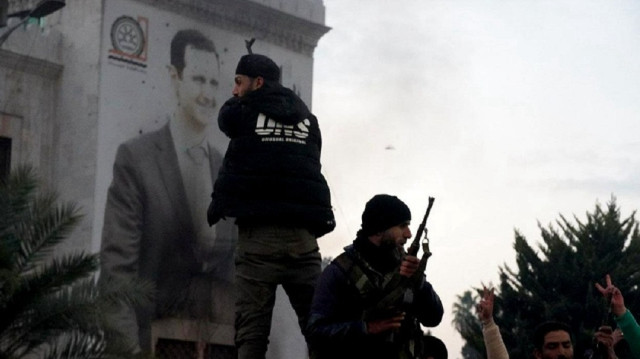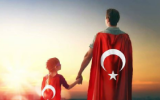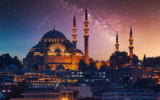
13 years of relentless war under ousted regime of Bashar Assad have left Yarmouk Palestinian Refugee Camp in ruins, but residents now striving to reclaim their lives, despite harsh winter conditions
After 13 years of conflict under the deposed Bashar al-Assad regime, residents of Damascus's Yarmouk Palestinian Refugee Camp are struggling to rebuild their lives in harsh winter conditions.
For years, the camp was besieged and devastated by bombs and other military attacks that destroyed homes, as well as widespread starvation among the population, with many forced to eat grass and animal feed to survive.
Yarmouk, Syria's largest Palestinian refugee camp, once housed nearly 400,000 Palestinian refugees, as well as Syrians and other nationals fleeing violence in neighboring countries.
Before the civil war broke out in 2011, the camp was a thriving, vibrant part of the city, known for its bustling streets and lively community. At the time, it was one of Damascus' busiest and most lively districts, where people from all walks of life lived and worked.
However, during the civil war, the camp was one of the most heavily impacted areas, with regime forces targeting it from 2013 to 2015.
According to international human rights organizations, approximately 200 people died due to starvation, with many more succumbing to a lack of medical supplies and treatment.
Disturbing images of long queues for aid became iconic, while regime forces were also accused of committing war crimes, including massacres and attacks on civilians. The siege, which lasted for years, saw residents living under the constant threat of violence and deprivation.
- Daesh/ISIS presence adds to people's agony
The presence of Daesh/ISIS in 2015 added to the region's complexity, with the people of Yarmouk caught in the crossfire. Civilians who were unable to flee the fighting became the primary targets of the escalating violence.
Today, returning families are trying to rebuild their homes and lives, often in makeshift conditions.
Once-proud buildings that served as schools, hospitals, and businesses are now ruins, with some barely standing and reduced to skeletal remnants. The largest mosque in the camp, which was built over nearly 50 years, has also been severely damaged.
Walls are adorned with Palestinian flags, and images of Hanzala, a symbol of Palestinian resistance, represent the enduring spirit of the community.
Some residents have begun repairing their homes, painting the walls, and rebuilding what they can with their limited resources.
- Separated by war
Fatma Ajaj, a 67-year-old Palestinian refugee, spoke with Anadolu about her heartbreak over losing her son and his family during the war.
Ajaj left the camp in 2012 as tensions rose following the revolution, but one of her sons stayed behind with his family to look after their homes.
She has not seen her son, his wife, or their two children since she left the camp.
"Our children here faced hunger, were forced to eat grass and animal feed, and suffered greatly. They stayed for about a year, but I couldn't visit them. We talked on the phone, and they said, 'Mom, we are hungry.' I told them, 'Get out of there,' but they said, 'We can't; we're under siege,'" she explained.
Despite her efforts to reach them, Ajaj was never able to reunite with her son and his family.
They were last heard from in 2014 when they told her they were at a checkpoint about to leave. They never made it out, though. And since then, Ajaj has yet to receive any information about them.
- ‘We want a life with dignity'
For some, like Yahya Salim, 42, the return to Yarmouk is about more than just rebuilding. Salim, who returned in 2021 after leaving in 2013, now raises pigeons on the roof of his damaged house.
He believes that pigeons symbolize peace and hopes that they will carry this message across the Arab world. Salim, who started keeping pigeons at the age of 13, sees them as a symbol of unity and healing.
"I started with 150 pigeons," Salim told Anadolu. "But when I came back, they were all gone. I missed them, but now I've started again. Pigeons bring peace. They don't hurt anyone. They love people."
Despite the challenges, Salim continues to care for the pigeons, believing that their presence symbolizes hope for the future.
He described the immense challenges faced by the camp's residents, many of whom have been unable to return home due to the devastation. "People don't have money to rebuild. Some are scavenging for food," he said. "But we still have hope."
Like many others, Salim is trying to rebuild his life from scratch, despite the scarcity of resources.
Despite the ongoing suffering, there remains a strong desire for peace and a return to normal life.
“We want to live; we want a life with dignity. Here, take a look at these houses—where are their owners? Aid needs to come here now, and these people need to build these houses. People have no money. Everyone survives on whatever they earn in a day.”
Bashar al-Assad, Syria's leader for nearly 25 years, fled to Russia after anti-regime groups took control of Damascus on Dec. 8, ending the Baath Party's regime, which had been in power since 1963.
The takeover came after Hayat Tahrir al-Sham fighters captured key cities in a lightning offensive that lasted less than two weeks.
A new administration led by Ahmed al-Sharaa has now taken charge.
Hello, the comments you share on our site are a valuable resource for other users. Please respect other users and different opinions. Do not use rude, offensive, derogatory, or discriminatory language.
The floor is all yours.








